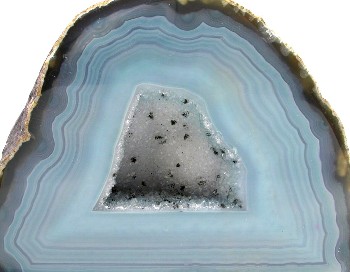WEBSITE HIGHLIGHTS: BUYER BEWARE
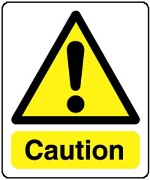 Our typical workday includes numerous phone calls from diamond shoppers who have questions about the diamond they are thinking of purchasing or have already purchased. We enjoy helping clients even if they do not intend to buy from us because our goal is for every diamond shopper to get the best diamond and usually that means getting the best advice.
Our typical workday includes numerous phone calls from diamond shoppers who have questions about the diamond they are thinking of purchasing or have already purchased. We enjoy helping clients even if they do not intend to buy from us because our goal is for every diamond shopper to get the best diamond and usually that means getting the best advice.
Based on the stories we hear, shoppers are definitely not getting quality advice or quality diamonds at many of the jewelry stores in our area or elsewhere in the country. Some of the stories we hear make us particularly frustrated since we are in the same industry as these stores. We have started compiling these stories so future diamond shoppers might have a little warning of what they might find at some of these less than trustworthy businesses.
Learn more about Buyer Beware…
DIAMOND SHOPPER MISTAKES: WARPED DIAMONDS
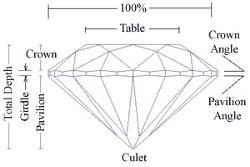 Beware of jewelers who mention the term “warped diamond,” especially if they use that term to describe a diamond you might be considering from some other retailer. Author, Fred Cuellar, introduced the warped concept in a book when he stated – If the girdle thickness plus the crown height plus the pavilion depth does not add up to the total depth, then the diamond is “warped”. Interestingly, almost every diamond any retailer has to sell is “warped” by his definition while diamonds he is selling are not “warped”. If this sounds like a scam to you, join the rest of the diamond industry.
Beware of jewelers who mention the term “warped diamond,” especially if they use that term to describe a diamond you might be considering from some other retailer. Author, Fred Cuellar, introduced the warped concept in a book when he stated – If the girdle thickness plus the crown height plus the pavilion depth does not add up to the total depth, then the diamond is “warped”. Interestingly, almost every diamond any retailer has to sell is “warped” by his definition while diamonds he is selling are not “warped”. If this sounds like a scam to you, join the rest of the diamond industry.
The reality is that the difference between the measurements has to do with how averages are calculated by the grading laboratories and in particular, how the girdle is measured.
For example, here are the averages and ranges of values determined by a Sarin machine for a particular diamond.
60.6% Total depth percentage
15.6% Crown height percentage – Average 15.2% (14.9-15.6)
+1.7% Girdle thickness percentage – Average 1.4% (1.0-1.7)
+42.4% Pavilion depth percentage – Average 42.3% (41.8-42.4)
=59.7% Total of percentages
Since the depth percentage is more than 0.5% different from the total of the percentages, Mr. Cuellar contends the diamond is “warped”.
The rest of the diamond industry simply points out that Sarin machines takes measurements of girdle thickness at the valley position. To make the numbers add up, the girdle measurements must be taken at the bezel “hill” position. As long as the GIA and other grading laboratories use the valley position for girdle measurement, the numbers for most of the diamonds in the world will not have numbers that add up exactly.
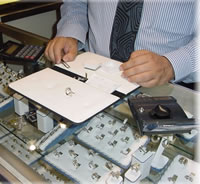 We have had several clients have jewelers tell them that diamonds we sold them are “too warped” to be set in a mounting, but the jeweler could find them diamonds that are not warped. We just encourage our clients to search online for the terms “warped diamonds” and they quickly discover that these jewelers, along with Fred Cuellar, are using a scare tactic to prey on unsuspecting diamond shoppers.
We have had several clients have jewelers tell them that diamonds we sold them are “too warped” to be set in a mounting, but the jeweler could find them diamonds that are not warped. We just encourage our clients to search online for the terms “warped diamonds” and they quickly discover that these jewelers, along with Fred Cuellar, are using a scare tactic to prey on unsuspecting diamond shoppers.
There are no “warped” diamonds and anyone using this term to dissuade you from purchasing a diamond is using a fraudulent tactic, so the sooner you exit their store the better.
WHAT IS THE APPRAISED VALUE?
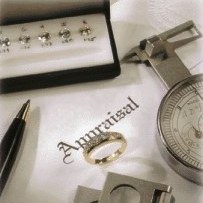 One of the frequent questions we get from diamond shoppers is “What will the diamond appraise for?” Shoppers are often confused by the difference between the price they pay and the appraised value so here is one of the answers we provided to that question.
One of the frequent questions we get from diamond shoppers is “What will the diamond appraise for?” Shoppers are often confused by the difference between the price they pay and the appraised value so here is one of the answers we provided to that question.
There are several values and prices associated with any diamond. For example, the wholesale price is what we pay to the cutter when we purchase a diamond.
The retail price is whatever a retailer sets as a price to sell to a consumer. It does not matter what a merchant calls himself or herself, if they sell to a consumer, they are a retailer. It is actually illegal to say you are offering “wholesale” prices to the public but stores say it all the time. There can be a wide range of retail prices. We have jewelry stores in local area that are double our prices for the same quality diamond ring and very high end stores charge even higher prices. Just keep in mind that when you walk out of the high-end jewelry store, your diamond just lost half its value because you paid twice as much as you could have.
There are several types of appraised value for a diamond or ring.
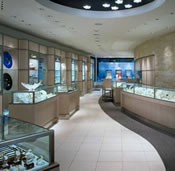 The most common type of appraised value is for insurance appraisals. This is targeting the “estimated retail replacement value” of the jewelry item. This sets the maximum your insurance company is responsible for paying for a claim but they can pay out much less since their policies usually state they can pay the replacement cost. We have many clients who purchased items in jewelry stores only to find they can only get half that price when they file an insurance claim. Once again, they paid twice as much as they needed to and the insurance company can purchase for less from companies, like Diamond Source of Virginia, that have very low overhead.
The most common type of appraised value is for insurance appraisals. This is targeting the “estimated retail replacement value” of the jewelry item. This sets the maximum your insurance company is responsible for paying for a claim but they can pay out much less since their policies usually state they can pay the replacement cost. We have many clients who purchased items in jewelry stores only to find they can only get half that price when they file an insurance claim. Once again, they paid twice as much as they needed to and the insurance company can purchase for less from companies, like Diamond Source of Virginia, that have very low overhead.
If you take an item to an appraiser and ask for an appraised value for what you can sell an item or what you should pay for an item, you will get a different number than used for insurance appraisals. The sell or buy value is going to typically be lower than the insurance value and will be closer to our prices. If you have to sell an item, the only way you will sell it quickly is to offer it for less than the lower retail prices. If you want to purchase an item, you should target the lower retail prices.
The interesting thing about appraised values is that there are no standards. You can take an item to five independent appraisers and they can all agree on what the item is (carat weight, color, clarity, cut, etc.) but you will likely get five very different values. We had one client take the same diamond to three appraisers and all three gave different values, the highest being double the lowest. He called in frustration wondering what was going on. I just pointed out that there are no standards for setting values and while many appraisers have training on identifying diamonds and gemstones, they do not have access to the current prices for those items so have to rely on formulas that seldom take into account the cut and other aspects of the diamond. We have many appraisers call us asking for prices of diamonds because they know the particular stone is unique and the only way to determine the price is to find prices of similar stones.
 There are jewelry stores who use appraised value as a big selling gimmick. They write up an appraisal that has some extremely high value and then point to what a “bargain” the item is at their reduced price. There are companies that furnish these preprinted appraisals so they look official. The percent they give you off some inflated appraisal value has no impact on the true value of the diamond. Value is determined by what you pay for the quality and quantity you receive. If we marked our prices up 100% and then gave everyone a 50% discount, some shoppers might feel better because they think they are getting a “deal” but the reality is the price is the price regardless of what discounts are contrived to get there.
There are jewelry stores who use appraised value as a big selling gimmick. They write up an appraisal that has some extremely high value and then point to what a “bargain” the item is at their reduced price. There are companies that furnish these preprinted appraisals so they look official. The percent they give you off some inflated appraisal value has no impact on the true value of the diamond. Value is determined by what you pay for the quality and quantity you receive. If we marked our prices up 100% and then gave everyone a 50% discount, some shoppers might feel better because they think they are getting a “deal” but the reality is the price is the price regardless of what discounts are contrived to get there.
ALROSA SELLS FOURTH OF WORLDS ROUGH DIAMONDS IN 2005
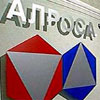 ALROSA, the Russian diamond company, sold more than $3.1 billion of rough diamonds in 2005, with $2.86 billion mined in Russia and the remainder mined in Africa. Their rough diamond sales rose from 18 to 25 percent of world output.
ALROSA, the Russian diamond company, sold more than $3.1 billion of rough diamonds in 2005, with $2.86 billion mined in Russia and the remainder mined in Africa. Their rough diamond sales rose from 18 to 25 percent of world output.
The growth in mine production is expected to face significant challenges in the years to come as the Russian mines mature and the mining operations must transition from open cut (pit) mines to underground mining. Underground operations are more expensive and require new technologies. ALROSA has proved to be very effective in finding ways to reduce development costs and increase the efficiency of mining and processing operations.
As required by the European Commission (EC) ruling in February, ALROSA is preparing for its reduced dependence on De Beers to purchase its rough diamonds. De Beers has agreed to reduce purchases from the Russian diamond giant by $100 per year until 2009 when they will no longer buy diamonds from ALROSA.
While ALROSA has traditionally been able to focus its energies on mining, it must now put resources toward the marketing of its product. This new direction will mean that ALROSA will be developing its presence in many countries far from the desolate landscapes of Siberia.
PRICE IMPACT OF FINISH GRADES
Polish and symmetry have relatively little impact on a diamond’s appearance but have a considerable influence on the price of diamonds. Based on a study of round diamonds, here are the price differences for various combinations of polish and symmetry ratings compared to the Good ratings, which generally mean polish and symmetry features are not visible to the eye.
Polish & Symmetry Grades
Price Difference
G - G
0%
VG - G
+2%
VG - VG
+3.7%
EX - VG
+5.8%
EX - EX
+13.1%
INCLUSIONS & BLEMISHES: CAVITY
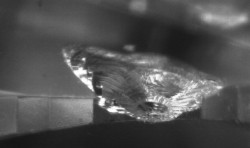 Cavities are openings on the surface of a diamond. Some cavities are caused by cleavage or by a blow, but generally are created when an included crystal is “pulled out” from the surface during polishing. A cavity is as the name implies a cavity, a void, a bubble or a lack of crystallization in the stone. They can be located on any part of the stone.
Cavities are openings on the surface of a diamond. Some cavities are caused by cleavage or by a blow, but generally are created when an included crystal is “pulled out” from the surface during polishing. A cavity is as the name implies a cavity, a void, a bubble or a lack of crystallization in the stone. They can be located on any part of the stone.
The photo at the right shows a cavity caused by a blow after the diamond was cut and polished. This particular cavity looks like a crater due to the magnification of the photo and the shape of the opening. Because of its location on the girdle, the blow that caused the cavity was probably at the girdle’s edge and the material separated along the diamonds cleavage plane.
A cavity created after cutting and polishing is unusual since the cutting and polishing process is quite traumatic for a diamond crystal. The cause of this cavity is still a mystery since the diamond was loose and was not exposed to any known force.
235 CARAT DIAMOND FOUND IN SOUTH AFRICA
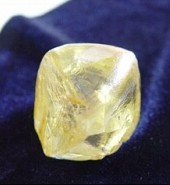 Nare Diamonds Limited recently announced the discovery of a very rare 235-carat rough diamond from its Schmidtsdrift diamond mine in South Africa. The mine was recently reopened after being purchased from the previous owner who shut down operations three years ago due to bankruptcy.
Nare Diamonds Limited recently announced the discovery of a very rare 235-carat rough diamond from its Schmidtsdrift diamond mine in South Africa. The mine was recently reopened after being purchased from the previous owner who shut down operations three years ago due to bankruptcy.
The mining operations are located on alluvial gravel deposits about 80 kilometers northwest of Kimberley in the Northern Cape Province.
The unusually large, egg-sized diamond is octahedron in shape and reported to be cape yellow color.
In addition to diamonds, minerals commonly exhibiting the simple octahedral form are magnetite, chromite, franklinite, spinel, pyrochlore, cuprite, and gold. Sometimes fluorite, pyrite, and galena also take this crystal structure.
GEMSTONES: AGATE
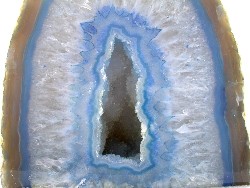 Agate is the most common variety of chalcedony, which is a form of quartz. In fact, agate has the same composition and physical properties of quartz but is distinguished from quartz by it strips and concentric layers.
Agate is the most common variety of chalcedony, which is a form of quartz. In fact, agate has the same composition and physical properties of quartz but is distinguished from quartz by it strips and concentric layers.
Most agates are formed in cavities of eruptive rocks of ancient laves. Gas bubbles trapped in solidifying lava fill with alkali and silica-bearing waters, which come together forming a gel-like substance. The alkali dissolves some of the iron in the surrounding lava forming iron hydroxide in the gel. As the gel loses water and crystallizes, layers of the iron hydroxide remain as colored bands.
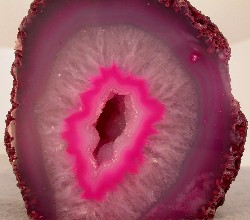 Agate is typically displayed with the stone cut at right angles to the colored layers. These cut pieces are then polished to highlight the beautiful stripes and bands, which are some of nature’s most beautiful displays of colors and textures.
Agate is typically displayed with the stone cut at right angles to the colored layers. These cut pieces are then polished to highlight the beautiful stripes and bands, which are some of nature’s most beautiful displays of colors and textures.
Sometimes the agate replaced organic material in the cavity and some of the organic material remains and become fossilized similar to the way ferns, insects, and other organic materials are captured in amber.
Varieties of agate are given names that describe the peculiarities in the shape and color of the bands. Here are just a few of the varieties of Agate:
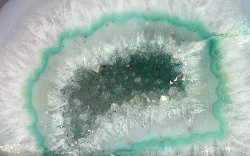 Blue Lace Agate – Light blue bands in a lacy or wavy pattern
Blue Lace Agate – Light blue bands in a lacy or wavy pattern- Crazy Lace Agate – Various colors in extremely varied patterns.
- Fire Agate – Dark brown agate with inclusions that cause the stone to be iridescent
- Moss Agate – Translucent agate with green to reddish green inclusions
- Onyx – Agate with straight and parallel banding lines
- Rainbow Agate – Thin sliced iridescent agate displaying all colors of the spectrum
- Snakeskin Agate – Reddish brown agate with black concentric brands
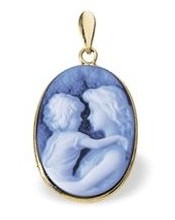 Many jewelry shoppers are familiar with cameo, many of which are figures (often a lady) carved out of stone. The cameo is carved out multi-colored layers of agate such that the figure left is a different color than the background. Cameos showing great artistic skill date back to ancient Greece in the 6th century BC.
Many jewelry shoppers are familiar with cameo, many of which are figures (often a lady) carved out of stone. The cameo is carved out multi-colored layers of agate such that the figure left is a different color than the background. Cameos showing great artistic skill date back to ancient Greece in the 6th century BC.
Agate occurs throughout the world since it can occur anywhere there was ancient volcanic activity. The mining of agate in the Nahe River valley of Germany was documented back to 1497 and continues to be one of the premier agate carving locations in the world with gem materials coming from all over the world.
One of the best-known locations of agate in the United States is the Petrified Forest National Park in Arizona. The Park has some of the world’s most colorful example of petrified wood agate in the form of logs.
Because agate is porous, a common treatment is the application of dye or stain. This creates even more dramatic colors than nature produced. One of the common uses of agate is where large specimens are cut and polished, then cut in two to form a pair of bookends.

